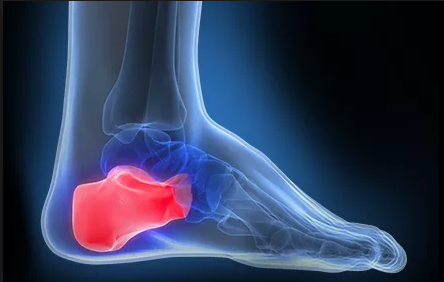If you are having pain at the bottom of the foot or heel, you are not alone. 10 percent of American adults are impacted by heel pain and it accounts for one million patient visits per year in the U.S. If you have made a sincere attempt to self-diagnose using Google, it is likely you have stumbled upon the words “plantar fasciitis”. More precisely, plantar fasciopathy, is the degeneration of the tissue at the bottom of the foot where it inserts onto the heel. Patients with this condition typically report foot pain that is at its worst first thing in the morning, or with the first several steps following prolonged sitting. The cause of plantar fasciopathy is multifactorial and is usually a culmination of repetitive micro traumas caused by faulty movement patterns at the foot, ankle, knee or hip. Risk factors for developing plantar fasciopathy include limited ankle joint mobility, high BMI, running, and prolonged weight bearing on hard surfaces.
After being accurately diagnosed by a healthcare professional, there are many treatment options available. Some treatments are well supported by the available research, while others are not. The consumer should be leery of products promising a quick fix. Avoid practitioners who promise relief solely through modalities such as laser treatment, ultrasound, iontophoresis, injection, or shockwave therapy. Instead, seek out practitioners who utilize a combination of evidence-based interventions to address the associated risk factors. Such interventions include foot orthoses, taping, night splints, change in footwear, counseling for weight loss and physical therapy with a specific emphasis on manual therapy to address joint and soft tissue restrictions as well as strengthening of hip and lower leg muscles.
If you are struggling with heel pain, the medical professionals here at Louisiana Orthopaedic Specialists can provide you with a compressive assessment and diagnosis. We are uniquely positioned to address all of your needs including orthotics, splints, physical therapy, and weight loss education. We are here to assist you and are committed to helping you get back on your feet. Pain free, of course!
-Lindsey Champagne, PT.
Works Cited
1. Hansen L, Krogh TP, Ellingsen T, Bolvig L, Fredberg U. Long-Term Prognosis of Plantar Fasciitis: A 5- to 15-Year Follow-up Study of 174 Patients With Ultrasound Examination. Orthop J Sports Med. 2018;6(3):2325967118757983. Published 2018 Mar 6. doi:10.1177/2325967118757983
2. Brantingham JW, Bonnefin D, Perle SM, et al. Manipulative therapy for lower extremity conditions: update of a literature review. J Manipulative Physiol Ther. 2012;35:127-166. http://dx.doi. org/10.1016/j.jmpt.2012.01.001
3. Renan-Ordine R, Alburquerque-Sendín F, de Souza DP, Cleland JA, Fernández-de-las-Peñas C. Effectiveness of myofascial trigger point manual therapy combined with a self-stretching protocol for the management of plantar heel pain: a randomized controlled trial. J Orthop Sports Phys Ther. 2011;41:43-50. http://dx.doi. org/10.2519/jospt.2011.3504
4. Sweeting D, Parish B, Hooper L, Chester R. The effectiveness of manual stretching in the treatment of plantar heel pain: a systematic review. J Foot Ankle Res. 2011;4:19. http://dx.doi. org/10.1186/1757-1146-4-19
5. van de Water AT, Speksnijder CM. Efficacy of taping for the treatment of plantar fasciosis: a systematic review of controlled trials. J Am Podiatr Med Assoc. 2010;100:41-51.
6. Meier K, McPoil TG, Cornwall MW, Lyle T. Use of antipronation taping to determine foot orthoses prescription: a case series. Res Sports Med. 2008;16:257-271. http://dx.doi.org/10.1080/15438620802310842
7. Snyder KR, Earl JE, O’Connor KM, Ebersole KT. Resistance training is accompanied by increases in hip strength and changes in lower extremity biomechanics during running. Clin Biomech (Bristol, Avon). 2009;24:26-34. http://dx.doi.org/10.1016/j. Clinbiomech.2008.09.009
8. Drake M, Bittenbender C, Boyles RE. The short-term effects of treating plantar fasciitis with a temporary custom foot orthosis and stretching. J Orthop Sports Phys Ther. 2011;41:221-231. http://doi.org/10.2519/jospt.2011.3348
9. Hume P, Hopkins W, Rome K, Maulder P, Coyle G, Nigg B. Effectiveness of foot orthoses for treatment and prevention of lower limb injuries: a review. Sports Med. 2008;38:759-779.
10. Lee WC, Wong WY, Kung E, Leung AK. Effectiveness of adjustable dorsiflexion night splint in combination with accommodative foot orthosis on plantar fasciitis. J Rehabil Res Dev. 2012;49:1557-1564.
11. Fong DT, Pang KY, Chung MM, Hung AS, Chan KM. Evaluation of combined prescription of rocker sole shoes and custom-made foot orthoses for the treatment of plantar fasciitis. Clin Biomech (Bristol, Avon). 2012;27:1072-1077. http://dx.doi.org/10.1016/j. Clinbiomech.2012.08.003
12. Butterworth PA, Landorf KB, Smith SE, Menz HB. The association between body mass index and musculoskeletal foot disorders: a systematic review. Obes Rev. 2012;13:630-642. http://dx.doi. org/10.1111/j.1467-789X.2012.00996.x
13. Stratton M, McPoil TG, Cornwall MW, Patrick K. Use of low-frequency electrical stimulation for the treatment of plantar fasciitis. J Am Podiatr Med Assoc. 2009;99:481-488.
14. Riddle DL, Schappert SM. Volume of ambulatory care visits and patterns of care for patients diagnosed with plantar fasciitis: a national study of medical doctors. Foot Ankle Int 2004;25:303–10.
15. Martin RL, Davenport TE, Reischl SF, et al. Heel pain—plantar fasciitis: revision 2014: clinical practice guidelines linked to the International Classification of Functioning, Disability, and Health from the Orthopaedic Section of the American Physical Therapy Association. J Orthop Sports Phys Ther. 2014;44:A1-A23. https://doi.org/10.2519/jospt.2014.0303
16. Pohl MB, Hamill J, Davis IS. Biomechanical and anatomic factors associated with a history of plantar fasciitis in female runners. Clin J Sport Med. 2009;19:372-376.
17. Werner RA, Gell N, Hartigan A, Wiggerman N, Keyserling WM. Risk factors for plantar fasciitis among assembly plant workers. PM R. 2010;2:110-116. http://dx.doi.org/10.1016/j.pmrj.2009.11.012
18. Irving DB, Cook JL, Young MA, Menz HB. Obesity and pronated foot type may increase the risk of chronic plantar heel pain: a matched case-control study. BMC Musculoskelet Disord. 2007;8:41. http://dx.doi. org/10.1186/1471-2474-8-41

